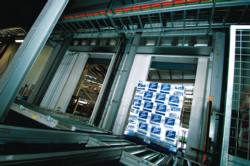Air curtains keep out dust and insects from bottle plant

Ensuring hygienic conditions in this huge bottle plant is the use of Airbloc air curtains over loading-bay doors to keep out dust and flying insects.
To prevent dust and flying insects getting into the new £300 million Quinn Glass bottle plant in Cheshire, Airbloc air curtains have been installed over the doors of loading bays. The plant can make 1.2 billion glass containers a year and is a one-stop shop for the production, storage and filling of product for the drinks industry. It has an area of over 145 000 m2 and accommodates 13 bottle production lines and two glass-melting furnaces. It is the largest facility of its kind in Europe and the first with an integrated filling line. 12 Airbloc AB300 air curtains have been installed over 13 of the 3 m-wide doorways. They deliver a powerful ‘sheet’ of air across the entire doorway — very effectively blocking the entry of dust and flies. These air curtains operate using fans and nozzles to create a stream of air that is directed down or across the door opening. A barrier of air separates the internal and external atmospheres by deflecting natural-convection airflow. This air shield reduces the entry of external air, dust, fumes and flying insects. It also prevents cooled air escaping. Air is drawn into the air curtain and discharged at critical velocity, volume flow and temperature — and at an angle to deliver optimum performance. The Airbloc curtains were fitted by Ashton Ventilation for M&E contractor Kramer of Halesowen.
Related links:


